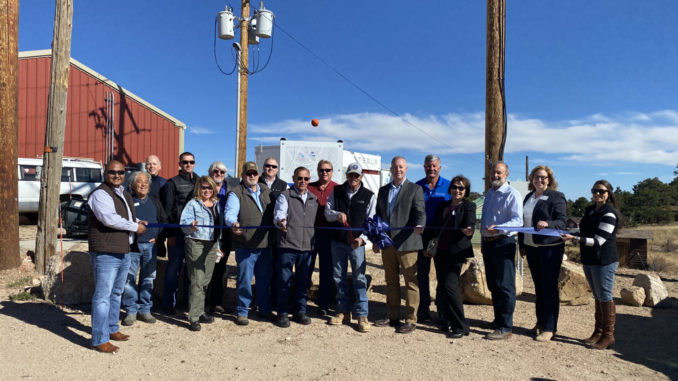
Community partners joined together in the remote mountain community of Red Feather Lakes on Thursday, October 7, to celebrate new technology that brings better resiliency.
Poudre Valley REA, a member-owned electric cooperative which serves the town located high in the Rocky Mountains, unveiled its first-ever microgrid – an interconnected system of loads and energy resources.
Jeff Wadsworth, President and CEO of Poudre Valley REA, commented on why they were proud to be part of such a community focused initiative. “One of our cooperative’s core values is to have a real concern for community. And this microgrid demonstrates just that by providing added resiliency for their energy needs, by working alongside community partners, and by sharing what we learn along the way with other electric co-ops across the nation so they can better serve their communities.”
The microgrid aims to better enable energy management and integrate various generation sources in Red Feather Lakes to increase resiliency for the members. When all the microgrid’s assets work together, the community should be able to maintain power for eight hours or more during times when other portions of the grid are temporarily unavailable. Extreme weather and wildfires can cause temporary and sometimes even extended power outages in the area.
Critical resources that are supported by this microgrid include fire response, emergency medical services, shelter, broadband, telecoms, food, fuel, water, and more.
“We are able to start learning what a microgrid does, what we can do with it and apply that knowledge to future projects,” said Wadsworth. “When costs and performance of batteries improve, we will be able to put microgrid technologies in other areas in our system.”
Partners involved in the project include Poudre Valley REA, The National Rural Electric Cooperative Association (NRECA), Tri-State, US Department of Energy, Sandia National Laboratories, Encorp, and the town of Red Feather Lakes’ Volunteer Fire Department and Library.
“Without the partners we had, this wouldn’t have been achievable,” Wadsworth said.
The Department of Energy defines a microgrid as “a group of interconnected loads and distributed energy resources within clearly identified electrical boundaries that acts as a single controllable entity with respect to the grid.”
The group of interconnected loads represent members in the Red Feather Lakes community who need electricity – such as the Volunteer Fire Department, the library, community building, post office, area businesses, and more.
Whereas the energy resources consist of three main assets:
- a 40-KW, 446-KWh Tesla Powerpack battery,
- 8-KW of solar photovoltaic,
- and a 130-KW propane generator.
A clearly identified electrical boundary exists between the end of the Poudre Valley REA power lines and the isolation point, which isolates the group of interconnected loads from the rest of the electric grid. To properly isolate the microgrid, Poudre Valley REA uses islanding technology which includes distribution power line upgrades and an Egility controller installed by Encorp.
Success of a microgrid is determined by its impact on reliability, security, affordability, and the integration of renewable and/or dispatchable resources. The size and scope of microgrids can differ greatly within the utility industry.
Support Northern Colorado Journalism
Show your support for North Forty News by helping us produce more content. It's a kind and simple gesture that will help us continue to bring more content to you.
BONUS - Donors get a link in their receipt to sign up for our once-per-week instant text messaging alert. Get your e-copy of North Forty News the moment it is released!
Click to Donate
